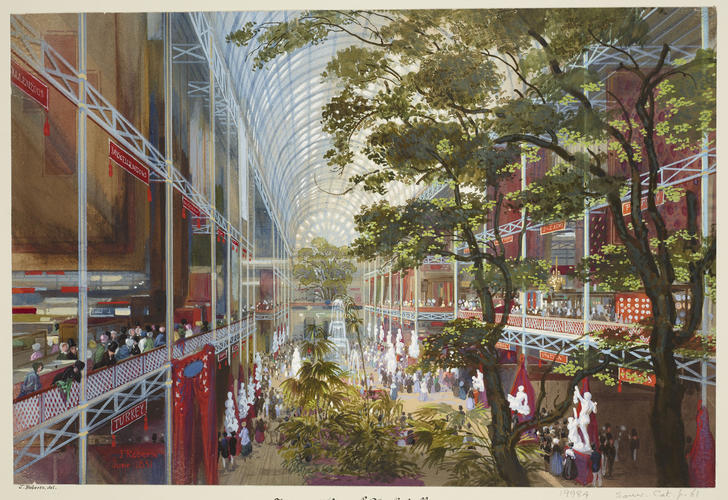The Great Exhibition: the Transept from the North Gallery dated 1851
Watercolour and bodycolour | 24.6 x 36.4 cm (whole object) | RCIN 919984
-
A watercolour depicting a detailed interior view of the crossing of the Crystal Palace from almost the same angle as RCIN 919988, but taken from gallery level, and showing the trees around which the building was constructed. Signed and dated at bottom left: J. Roberts / June 1851.
In his capacity as President of the Society of Arts, Prince Albert set up a committee to organise exhibitions with the aim of improving British industrial design. An exhibition in Birmingham in 1849 was followed by the first truly international exhibition, the Great Exhibition of Products of Industry of All Nations, held in Joseph Paxton's 'Crystal Palace' in Hyde Park, London, in the summer of 1851. Half the exhibition space was devoted to British manufacturing, and the other half was offered to foreign countries to display their achievements and specialisms. Six million people visited the exhibition to see over 100,000 exhibits from around the world, divided broadly into raw materials, machinery, manufactures and the fine arts; Queen Victoria herself visited no fewer than thirty-four times. The substantial profits were used to establish the South Kensington Museum, renamed the Victoria and Albert Museum in 1899. The Queen wrote to her uncle Leopold, King of the Belgians, that the inaugeration of the Great Exhibition was the "greatest day in our history."
Osler's crystal fountain, seen in the background in this watercolour, stood 27 feet high and the glass used for it weighed 4 tons. A contemporary obsrver described it as a "fantastic spectacle", describing it "glittering with all the colours of the rainbow" and the water flowing from it producing a "delicious bubbling sound" (Tallis's History and Description of the Crystal Palace, and the Exhibition of the World's Industry in 1851, 1852). The fountain was dismantled at the end of the exhibition and reassembled along with the Crystal Palace at Sydenham.
In addition to a sequence of watercolours commissioned by Victoria and Albert to be reproduced by Dickinson Bros in chromolithography, the royal couple also commissioned James Roberts, whom they patronised extensively, to paint views of the Great Exhibition to be mounted in their private series of View Albums (see below for more information). This watercolour was originally mounted in View Album V.
Queen Victoria and Prince Albert compiled nine View Albums during their marriage. These albums contained watercolours and drawings documenting their life together and were arranged in chronological order. The albums were dismantled in the early twentieth century and rebound in new volumes both in a different arrangement and with additional items, but a written record of their original contents and arrangement still exists.Provenance
Commissioned by Queen Victoria for her View Albums series (mounted in the fifth album). Roberts was paid for drawings of the Great Exhibition in August and November 1851.
-
Creator(s)
-
Medium and techniques
Watercolour and bodycolour
Measurements
24.6 x 36.4 cm (whole object)
Object type(s)
Other number(s)
RL 19984








